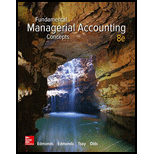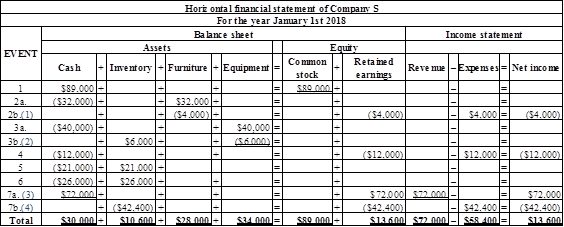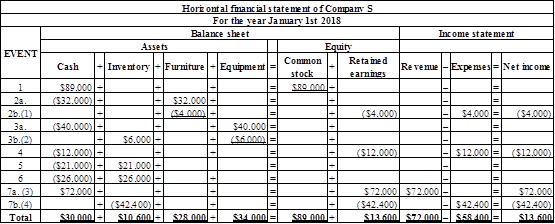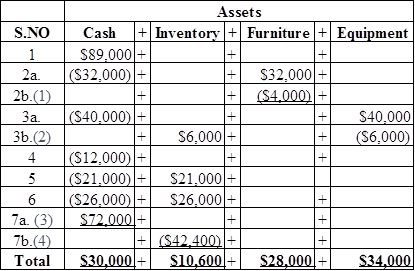
a.
The total product cost and average cost per unit.
a.
Explanation of Solution
Product cost:
It is the cost incurred by the company during the process of manufacturing the product.
Given information:
- The raw material is $26,000.
- The wages for production workers are $21,000.
- Manufacturing equipment is $40,000, its salvage value is $4,000, and an expected life is 6 years.
- The completed production of Company S is 10,000 units.
The calculation of total product cost for the year 2018 is as follows:

Hence, the total cost of the product for the year 2018 is $53,000.
The calculation average cost per unit for the year 2018 is as follows:
Hence, the average cost per unit for the year 2018 is $5.30.
Working notes:
The calculation of manufacturing
Hence, the manufacturing overheads are $6,000.
(1)
b.
The cost of goods sold that appears in 2018 income statement.
b.
Explanation of Solution
Cost of goods sold
The cost of goods sold is the accumulation of all the direct costs incurred in the process of producing a product. It excludes the indirect expenses.
Given information:
- The total number of units sold by Company S is 8,000 units.
The calculation of total cost of goods sold for the year 2018 is as follows:
Hence, the total cost of goods sold is $41,400.
c.
The cost of ending inventory that appears on 31st December 2018
c.
Explanation of Solution
Inventory:
It is the term for products that are ready for sale and raw materials that are used in the making of the final product.
Given information:
- The total number of units sold by Company S is 8,000 units.
- The completed production of Company S is 10,000 units.
The calculation of ending inventory for the year 2018 is as follows:
Hence, the ending inventory for the year 2018 is $10,600.
d.
The total amount of net income for the year 2018.
d.
Explanation of Solution
Financial statement:
The financial statement which reports the revenues and expenses from business operations and the result of those operations as the net income or net loss for a particular time period is referred to as an income statement.
Given information:
- The raw material is $26,000.
- The wages for production workers is $21,000.
- Manufacturing equipment is $40,000, its salvage value is $4,000, and an expected life is 6years.
- The total number of units sold by Company S is 8,000 units at cost of $9 per unit.
- The completed production of Company S is 10,000 units.
- The common stock of the Company S is $89,000.
- The purchased furniture for office at $32,000 and an expected life is 8years.
- The Company pays $12,000 as salary and $21,000 as wages for the production purpose.
- Company S pays 26,000 for the raw materials.
The calculation of net income of the Company S for the year 2018 is as follows:

Table (2)
Hence, the net income of the Company for the year 2018 is $13,600.
Working note:
The calculation of
Hence, the depreciation value of furniture is $4,000.
(1)
The calculation of depreciation value for manufacturing equipment’s:
Hence, the depreciation value of the manufacturing equipment is $6,000.
(2)
The calculation of total units sold at the rate of $9 per unit.
The total units sold by the Company S are 72,000.
(3)
The calculation of total inventory at the average cost per unit.
The total inventory at the average cost is 42,400.
(4)
e.
The total amount of net income for the year 2018.
e.
Explanation of Solution
Financial statement:
The financial statement which reports the revenues and expenses from the business operations and the result of those operations as net income or net loss for a particular time period is referred to as an income statement.
Given information:
- The raw material is 26,000.
- The wages for production workers is $21,000.
- Manufacturing equipment is $40,000, its salvage value is $4,000, and an expected life is 6years.
- The total number of units sold by Company S is 8,000 units at cost of $9 per unit.
- The completed production of Company S is 10,000 units.
- The common stock of the Company S is $89,000.
- The purchased furniture for office at $32,000 and an expected life is 8 years.
- The Company pays $12,000 as salary and $21,000 as wages for the production purpose.
- Company S pays 26,000 for raw materials.
The calculation of

Table (3)
Hence, the net income of the Company for the year 2018 is $13,600.
Working note:
The calculation of depreciation value for furniture:
Hence, the depreciation value of furniture is $4,000.
(1)
The calculation of depreciation value for manufacturing equipment’s:
Hence, the depreciation value of manufacturing equipment is $6,000.
(2)
The calculation of total units sold at the rate of $9 per unit.
The total units sold by the Company S are 72,000.
(3)
The calculation of total inventory at the average cost per unit.
The total inventory at the average cost is 42,400.
(4)
f.
The total assets that appears on the balance sheet.
f.
Explanation of Solution
Financial statement:
The financial statement which reports revenues and expenses from business operations and the result of those operations as net income or net loss for a particular time period is referred to as an income statement.
Given information:
- The raw material is $26,000.
- The wages for production workers is $21,000.
- Manufacturing equipment is $40,000, its salvage value is $4,000 and an expected life is 6years.
- The total number of units sold by Company S is 8,000 units at cost of $9 per unit.
- The completed production of Company S is 10,000 units.
- The common stock of the Company S is $89,000.
- The purchased furniture for office at $32,000 and an expected life is 8 years.
- The Company pays $12,000 as salary and $21,000 as wages for the production purpose.
- Company S pays 26,000 for raw materials.
The table showing calculation of assets:

Table (4)
The calculation of total assets is as follows:

Hence, the total amount of assets of the Company for the year 2018 is $102,600.
Working note:
The calculation of depreciation value for furniture:
Hence, the depreciation value of furniture is $4,000.
(1)
The calculation of depreciation value for manufacturing equipment’s:
Hence, the depreciation value of manufacturing equipment is $6,000.
(2)
The calculation of total units sold at the rate of $9 per unit.
The total units sold by the Company S are 72,000.
(3)
The calculation of total inventory at the average cost per unit.
The total inventory at the average cost is 42,400.
(4)
Want to see more full solutions like this?
Chapter 1 Solutions
Fundamental Managerial Accounting Concepts
- Walsh plc sells wash machines and provides a one-year warranty against faults occurring after sale. Platt estimates that if all goods under warranty at its statement of financial position date of 31 December 2022 need minor repairs the total cost would be £ 6 million. If all the products under warranty needed minor repairs the total cost would be £ 24 million. At 31 December 2023 these amounts have risen to £ 7 million and £ 26 million respectively. Based on previous years` experience, Walsh estimates that the 80% of the products will require no repairs, 18% will require minor repairs and 2% will require major repairs. During the year ended 31 December 2023 actual costs of repair under the warranty amounted to £ 1,400,000. Required: a. b. What are the distinctions between liabilities, provisions and contingent liabilities under IAS 37 “Provisions”? Explain the accounting treatment of the warranty in Walsh plc`s financial statements for the year ended 31 December 2023, qualifying…arrow_forwardPlease provide answer this financial accounting questionarrow_forwardI need help finding the accurate solution to this financial accounting problem with valid methods.arrow_forward

 AccountingAccountingISBN:9781337272094Author:WARREN, Carl S., Reeve, James M., Duchac, Jonathan E.Publisher:Cengage Learning,
AccountingAccountingISBN:9781337272094Author:WARREN, Carl S., Reeve, James M., Duchac, Jonathan E.Publisher:Cengage Learning, Accounting Information SystemsAccountingISBN:9781337619202Author:Hall, James A.Publisher:Cengage Learning,
Accounting Information SystemsAccountingISBN:9781337619202Author:Hall, James A.Publisher:Cengage Learning, Horngren's Cost Accounting: A Managerial Emphasis...AccountingISBN:9780134475585Author:Srikant M. Datar, Madhav V. RajanPublisher:PEARSON
Horngren's Cost Accounting: A Managerial Emphasis...AccountingISBN:9780134475585Author:Srikant M. Datar, Madhav V. RajanPublisher:PEARSON Intermediate AccountingAccountingISBN:9781259722660Author:J. David Spiceland, Mark W. Nelson, Wayne M ThomasPublisher:McGraw-Hill Education
Intermediate AccountingAccountingISBN:9781259722660Author:J. David Spiceland, Mark W. Nelson, Wayne M ThomasPublisher:McGraw-Hill Education Financial and Managerial AccountingAccountingISBN:9781259726705Author:John J Wild, Ken W. Shaw, Barbara Chiappetta Fundamental Accounting PrinciplesPublisher:McGraw-Hill Education
Financial and Managerial AccountingAccountingISBN:9781259726705Author:John J Wild, Ken W. Shaw, Barbara Chiappetta Fundamental Accounting PrinciplesPublisher:McGraw-Hill Education





